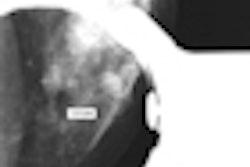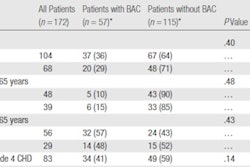Breast imagers are doing a better job of detecting breast cancer, according to a study published online May 26 in Radiology that evaluated 2.5 million screening mammograms in the U.S. over a nine-year period.
In the study of six mammography registries in the Breast Cancer Surveillance Consortium from 1996 to 2004, researchers found that sensitivity increased from 71.4% in 1996 to 83.8% in 2004. In other findings, recall rate increased from 6.7% in 1996 to 8.6% in 2004, while specificity decreased from 93.6% in 1996 to 91.7% in 2004 (Radiology, online May 26, 2010).
"The net effect was that the increase in sensitivity outweighed the decrease in specificity," lead author Laura Ichikawa, a biostatistician at the Group Health Research Institute in Seattle, told AuntMinnie.com. "There was an overall improvement in accuracy."
The researchers found that these time trends remained after accounting for both risk factors and individual radiologists' performance.
To examine time trends in radiologists' interpretive performance at screening mammography, the researchers collected data on subsequent screening mammograms performed from 1996 to 2004 in women ages 40 to 79 who received one-year follow-up for breast cancer.
Each of the women included in the study had at least one prior mammogram and at least nine months between mammography exams. Ichikawa's team used cancer registries and pathology databases to identify breast cancers that occurred within one year of any mammogram included in the study.
The study included data from 2,542,049 screening mammograms from 971,364 women. Studies with BI-RADS assessment of category 0, 4, or 5 were considered positive, while studies with category 1 or 2 assessments were considered negative. Studies assessed at BI-RADS category 3 with a recommendation for immediate follow-up were also considered to be positive.
Sensitivity was determined as the proportion of positive mammograms among cancers in the follow-up period, and specificity was calculated as the proportion of negative mammograms among noncancers in the follow-up period.
Ichikawa's group used generalized estimating equation (GEE) and random-effects models to test for linear trends. The researchers also performed receiver operator characteristics analysis to examine sensitivity and specificity and to determine the area under the curve (AUC).
GEE analysis revealed a significant increase over time in the recall rate (odds ratio [OR] = 1.03 per year; 95% confidence interval [CI]: 1.01-1.04; p < 0.001) and sensitivity (OR = 1.10 per year; 95% CI: 1.07-1.12; p < 0.001). Specificity decreased, however (OR = 0.97 per year; 95% CI: 0.96-0.99; p< 0.001).
The team discovered that the AUC increased over time, climbing from 0.869 (95% CI: 0.861-0.877) for 1996-1998 to 0.884 (95% CI: 0.879-0.890) for 1999-2001 and to 0.891 (95% CI: 0.885-0.896) for 2002-2004 (p < 0.001).
"The ability of radiologists to discriminate cancers from noncancers as measured by using the empirical AUC with use of BI-RADS assessment increased during this period," Ichikawa and colleagues wrote. "This finding indicates that the increase in sensitivity more than offset the decrease in specificity as the recall rate increased."
The study did not find a significant trend in the distribution of tumor size and histologic findings.
One explanation for these trends could be the implementation over time of the Mammography Quality Standards Act (MQSA), the researchers noted. Also, the increase in recall rate could be partly attributable to increasing concern by radiologists about malpractice suits.
The researchers acknowledged several limitations of the study, including some missing information on current postmenopausal hormone therapy use (14% of cases), menopausal status (12%), time since previous mammogram was obtained (4%), BI-RADS breast density (21%), and comparative mammograms (14%). Time trends did not differ, however, when the researchers adjusted for these covariates among mammograms without missing data.
Ichikawa and colleagues also did not assess many factors that affect mammographic performance, including characteristics of facilities and radiologists, new technology, and mammography technical aspects. They also did not adjust for the use of digital mammography and mammography with computer-aided detection (CAD) technology.
"However, results of subgroup analysis showed that time trends in performance measures are similar when digital mammograms and mammograms with CAD are excluded," they wrote. "Use of these technologies was relatively rare during our study period, with 3% of the data from digital mammography and 15% from mammography with the use of CAD."
Nonetheless, the researchers concluded that radiologists improved overall in their interpretive performance of subsequent screening mammography over the study period.
"We can't attribute [the sensitivity improvements] to any one thing," Ichikawa said. "It has a lot to do with MQSA's training, education, and equipment standards. Our study ended in 2004, just when new mammography technology was coming into use, so it's important to continue to look at how performance changes over time and actually get at what's causing the change."
By Erik L. Ridley and Kate Madden Yee
AuntMinnie.com staff writers
May 27, 2010
Related Reading
Lesions 'probably benign' on breast MRI may not need biopsy, May 27, 2010
Hospital to retake 900 mammograms due to employee error, May 12, 2010
Breast surgeons could be option for reading mammograms, May 10, 2010
Mammograms catch few cancers in young women: study, May 4, 2010
Conn. breast density law causes conundrum for mammo sites, April 29, 2010
Copyright © 2010 AuntMinnie.com



















